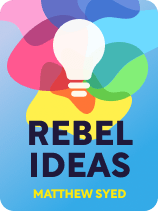

This article is an excerpt from the Shortform book guide to "Rebel Ideas" by Matthew Syed. Shortform has the world's best summaries and analyses of books you should be reading.
Like this article? Sign up for a free trial here.
What impact does diversity have on innovation? How does cognitive diversity lead to recombinant innovation?
According to Matthew Syed, cognitively diverse groups can harness the diverse knowledge of their members to create more innovative ideas. His book Rebel Ideas presents the argument that cognitive diversity fosters recombinant innovation.
Keep reading to learn why Syed argues that cognitive diversity leads to recombinant innovation.
Recombinant Innovation in Diverse Groups
In Rebel Ideas, Matthew Syed discusses the impact of cognitive diversity on innovation. In particular, he argues that cognitive diversity—both in individuals and in institutions—leads to recombinant innovation, because it brings ideas from disparate fields together.
The Two Types of Innovation
Syed explains that there are two types of innovation: incremental and recombinant. Incremental innovation refers to small improvements that occur within a field. For example, incremental innovation occurs when Apple makes gradual improvements to the iPhone, like changing its dimensions. By contrast, recombinant innovation occurs when two ideas from different fields come together. For instance, the creation of the iPhone represented recombinant innovation, as Apple combined ideas about telephones with those about computers.
(Shortform note: Although recombinant innovation can result in broader change, experts argue that incremental innovation also offers crucial benefits. For instance, while recombinant innovations carry a high risk of failure, incremental innovations are much lower risk, delivering more secure returns. Moreover, because recombinant innovation often takes longer to implement, incremental innovation can help keep your customers engaged in the meantime.)
How to Foster Recombinant Innovation
Though both forms of innovation are important, Syed asserts that recombinant innovation is the driving force behind dramatic change, and he focuses on how individuals and institutions can foster recombinant innovation.
As for individuals, Syed points out that immigrants are inclined toward innovation: For example, over half of U.S.-based Nobel Prize recipients were born abroad. According to Syed, this occurs because immigrants’ exposure to different cultures helps them question assumptions and fuse different ideas. In turn, they’re more likely to come up with recombinant innovations.
(Shortform note: In addition to being more innovative themselves, a 2023 study finds that immigrants’ presence also makes native-born inventors more innovative. In other words, native inventors who collaborated with immigrants had higher innovation output, on average.)
As for institutions, Syed argues that they must allow an open flow of information among diverse individuals to cultivate recombinant innovation. In particular, Syed argues that sharing ideas leads to information spillover: Innovative ideas become stronger as they’re exposed to more people, who further refine and improve them. Moreover, because diverse groups propose more distinct improvements to innovative ideas, they enjoy greater benefits from information spillover. So, Syed concludes that we shouldn’t view innovation only as the product of individual creative thinkers, but also of institutions that encourage these thinkers to interact.
(Shortform note: To foster information spillover in the workplace, experts recommend building a transparent environment that encourages collaboration. This could include rewarding employees who freely share their ideas, whether in performance reviews or even through a simple shout-out. Additionally, because sharing ideas in large groups can feel intimidating, others recommend holding smaller meetings with an emphasis on open conversation.)
To illustrate his point on recombinant innovation and institutions, Syed compares two technological hubs in the 1970s: Massachusetts’s Route 128 and California’s Santa Clara Valley, later called Silicon Valley. Syed observes that, in 1975, Route 128 had many advantages over Silicon Valley, such as cheaper land and lower wages. But, geographical distance and a tendency toward secrecy made Route 128’s companies insular, and ideas only traveled within individual companies. By contrast, Silicon Valley’s companies were densely concentrated and socially interconnected; engineers from different companies often spent time together, fostering cognitive diversity and widespread information spillover.
(Shortform note: Experts observe that the practice of “knowledge sharing” is widespread in Silicon Valley: Engineers have high turnover rates as they frequently switch companies, often bringing new ideas and product development plans with them. Consequently, Silicon Valley’s technology companies regularly develop similar products, leading to widespread success when any individual product succeeds.)
Syed attributes Silicon Valley’s later success and Route 128’s later failure to the information spillover that only Silicon Valley benefited from. The upshot of this difference is clear: Today, Silicon Valley is the home of tech giants like Apple, Google, and eBay, while many of Route 128’s tech giants have since shuttered.

———End of Preview———
Like what you just read? Read the rest of the world's best book summary and analysis of Matthew Syed's "Rebel Ideas" at Shortform.
Here's what you'll find in our full Rebel Ideas summary:
- Why diverse groups are more collectively intelligent than homogeneous ones
- Actionable advice for creating cognitively diverse groups
- Why systems shouldn't be designed to fit the "average" person






